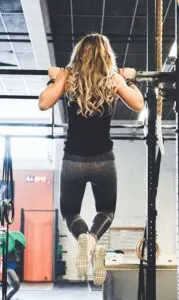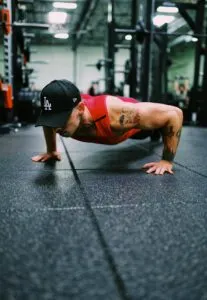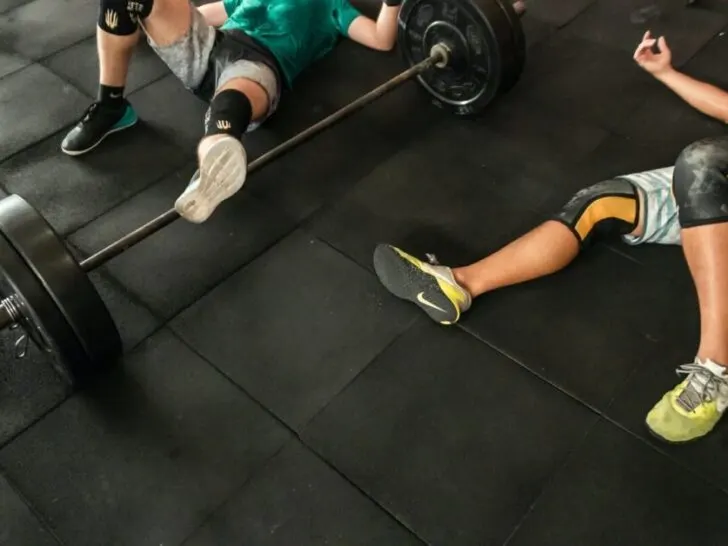Some of the links in this post are affiliate links. This means if you click on the link and purchase the item, we will receive an affiliate commission from the vendor at no extra cost to you. These business relationships allow us to keep bringing you great EatMoveHack content. All opinions remain our own.
In our next installment of the Basement Series, we are going to talk about testing days. “Without continual growth and progress, such words as improvement, achievement, and success have no meaning.” Benjamin Franklin. We use our testing days to assess our progress. These testing days help to ensure that we are moving forward.
We test every weekend. Again, we aren’t always looking to break personal bests on every movement every weekend. Rather, we are trying to determine where we are progressing and where we may be stalling.
Also, testing, at least in my opinion, is a lot of fun. It gives you something concrete to point to at the end of a hard week or work. Plus, it gives us a chance to step back and watch our training partners try to hit their goals. Normally when we are working out we are all head-down and not paying too much attention to our training partners around us. On testing days we get a real chance to watch the progress.
Testing Day #1
 As I said above, we use testing days every weekend. We have two cycles of testing days so we aren’t testing the same movements every week. Rather, we test each movement every other week.
As I said above, we use testing days every weekend. We have two cycles of testing days so we aren’t testing the same movements every week. Rather, we test each movement every other week.
So, here are the movements we are assessing on testing day #1:
- Maximum Pull-ups. If you aren’t able to perform a pull up just yet you can use different varieties like pull-up hangs, negatives or chin-ups;
- Maximum Dips. Again, if you aren’t there yet for a full dip then chose from a challenging variation;
- Maximum Time Elevated Feet Hand Supported Plank. If feet up is too difficult then simply keep your feet on the floor;
- Maximum Time Weighted Goblet Squat Hold. You are looking to hold the bottom of this position as long as you can with a challenging weight; and
- Maximum Strict Shoulder Press. You can use dumbbells, kettlebells, barbells, etc. Make sure that you either testing both arms or using a barbell to test both at the same time.
We make sure to warm-up for about 16 minutes before we start the testing. Our warmup is two rounds of our 10,000 Kettlebell Swing Challenge workout from the Basement Series.
You do not want to start testing your limits if you are cold. Make sure to warm-up.
Keep a running list of your numbers for each movement. You will be adding to these the next time you go through Testing Day #1 again in two weeks.
Testing Day #2
 Alright, testing day #2 is structured in a similar way. We go through our 16-minute warm-up as discussed above. Then we start in on the movements. Testing day #2 movements are:
Alright, testing day #2 is structured in a similar way. We go through our 16-minute warm-up as discussed above. Then we start in on the movements. Testing day #2 movements are:
- Maximum Push-ups. Look for variations if you are unable to cleanly perform push-ups;
- Maximum Ring-Rows. We have wooden rings that we use for this but you can do any kind of maximum test for your pulling movement;
- Maximum Wall-Balls in 1 minute. This one will tax your system if you are really trying hard to get the maximum number of wall-balls;
- Maximum Single-Arm Thrusters. We use heavy kettlebells and test each arm individually. You can use kettlebells, sandbags, dumbbells, or barbells. Just test the movement of a thruster; and
- Maximum Timed Forward Kettlebell Hold. Here we test how long we can hold a kettlebell at shoulder height straight out in front of us. This is a challenging movement because our shoulders are not very strong with arms fully extended away from our body.
That’s testing day #2. Track your score and be ready to re-test in two more weeks.
What Weight?
So, we have adopted a rule that, for an of the max movements, if you can perform over 10 reps then you have to move up weight for the next test. So, if you are able to do 12 thrusters at 35, the next time around you will move up to the next heaviest kettlebell and start testing from that weight. We want to continue to have gross strength development in these maximum movements and to ensure we are doing that we have used this 10-rep point to indicate to ourselves that we need to go heavier.
Now, we have also decided that the same is true for the bodyweight movements. So, if we are able to do more than 10-reps of full body weight on the dips, the next time we test we must add weight. We use a weight belt to hold kettlebells. This way we are continuing to challenge ourselves with bodyweight movements as well.
Conclusion:
So, this is how we test ourselves each weekend. This has become a bit of a ritual for us as we work hard throughout the week and then test each weekend. I, personally, really enjoy the testing element. It helps us stay on track and allows us to set realistic goals for our push forward.
Alright, until the next installment of the Basement Series – check out the other articles in this set:

